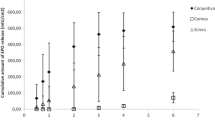Abstract
In order to check the entrance site of serum albumin into the aqueous humor, rabbits were injected intravenously either with Evans blue (which reacts very quickly with albumin) or horseradish peroxidase. The Evans blue-albumin complex (Eb-a) was traced to the posterior chamber as early as I min after injection by examining frozen half eyes. The Eb-a was localized in frozen sections by fluorescence microscopy in the stroma of the ciliary and iridial processes, as well as in the lumen of all blood vessels from 1 to 60 min after injection even at doses as low as 3 mg/kg. The peroxidase activity was also localized on these same structures from 8 min to 4.5 h. Neither tracer was visualized in the iris stroma outside the lumen of blood vessels. This was also true for experiments with Eb (75 mg/kg) in which the blood-aqueous barrier was disrupted. The concentration (m/v) of Evans blue and the peroxidase activity in the aqueous humor of the anterior chamber were estimated by spectrophotometry. The morphological integrity of the blood-aqueous barrier was demonstrated by electron microscopy in all peroxidase-injected rabbits. Considering that (a) the Eb-a appeared first in the posterior chamber, (b) there was a high concentration of tracers in the stroma of the ciliary and iridial processes, (c) neither tracer was visualized in the iris stroma, (d) there was no evidence of disruption of the blood-aqueous barrier, and (e) the concentration of both tracers in the aqueous humor kept increasing up to 4 h after injection, it was assumed that serum macromolecules entered first the posterior chamber and subsequently migrated to the anterior chamber. Most likely they passed in between the cells of the inner layer of the ciliary epithelium, the site of the so-called blood-aqueous barrier. No evidence was found indicating migration of macromolecules from the stroma of the processes directly to the anterior chamber via the iris root.
Similar content being viewed by others
References
Barsotti MF, Bartels SP, Freddo TF, Kamm RD (1992) The source of protein in the aqueous humor of the normal monkey eye. Invest Ophthalmol Vis Sci 33:581–595
Berman ER (1991) Biochemistry of the eye. Plenum Press, New York, pp 151–192
Bill A (1986) The blood-aqueous barrier. Trans Ophthalmol Soc UK 105:149–155
Cunha-Vaz JG (1979) The blood-ocular barriers. Survey Ophthalmol 23:279–296
Cunha-Vaz JG, Maurice DM (1967) The active transport of fluorescein by the retinal vessels and retina. J Physiol 91:467–486
Dernouchamps JP (1982) The proteins of the aqueous humor. Doc Ophthalmol 53:193–248
Duke-Elder S, Gloster J (1968) The aqueous humor. In: Duke-Elder S (ed) The physiology of the eye and vision, vol IV Henry Kimpton, London, pp 104–200
Freddo TF, Bartels SP, Barsotti MF, Kamm RD (1990) The source of proteins in the aqueous humor of the normal rabbit. Invest Ophthalmol Vis Sci 31:125–137
Freedman FB, Johnson JA (1969) Equilibrium and kinetic properties of the Evans blue-albumin system. Am J Physiol 216:675–681
Gaastra W (1984) Enzyme-linked immunosorbant assay (ELISA). In: Walker JM (ed) Methods in molecular biology, vol 1. Proteins. Humana Press, Clifton, NJ, pp 349–355
Gooderham K (1984) Transfer techniques in protein blotting. In: Walker JM (ed) Methods in molecular biology, vol 1. Proteins. Humana Press, Clifton, NJ, pp 165–178
Haddad A, Laicine EM, Almeida JC, Costa MSA (1990) Partial characterization, origin and turnover of glycoproteins of the rabbit vitreous body. Exp Eye Res 51:139–143
Haddad A, Laicine EM, Almeida JC (1991) Origin and renewal of the intrinsic glycoproteins of the aqueous humor. Graefe's Arch Clin Exp Ophthalmol 229:371–379
Krootila K, Uusitalo H, Lehtosalo JI, Palkama A (1987) Recovery of the blood-aqueous barrier after topical chemical irritation in the rabbit eye. Graefe's Arch Clin Exp Ophthalmol 225:272–276
Laemmli UK (1970) Cleavage of structural proteins during the assembly of the head of bacteriophage T4. Nature 227:680–685
Maurice DM (1959) Protein dynamics in the eye studied with labelled proteins. Am J Ophthalmol 47:361–367
Pavao AF, Lee DA, Johnson MC, Anderson PJ, Epstein DL (1989) Two-dimension gel electrophoresis of calf aqueous humor, serum, and filter-bound proteins. Invest Ophthalmol Vis Sci 30:731–738
Radius RL, Anderson DR (1980) Distribution of albumin in the normal monkey eye as revealed by Evans blue fluorescence microscopy. Invest Ophthalmol Vis Sci 19:238–243
Raviola G (1977) The structural basis of the blood-ocular barriers. Exp Eye Res 25 [Suppl]:27–63
Raviola G (1982) Morphological aspects of aqueous humor production. In: Hollyfield JG (ed) The structure of the eye. Elsevier North Holland, New York, pp 331–340
Shabo AL, Maxwell DS (1972) The blood-aqueous barrier to tracer protein: a light and electron microscopic study of the primate ciliary process. Microvascular Res 4:142–158
Smith RS, Rudt LA (1973) Ultrastructural studies of the blood-aqueous barrier. 2. The barrier to horseradish peroxidase in primates. Am J Ophthalmol 76:937–947
Zak R (1990) Basic facts for basic science. Raven Press, New York, pp 247–249
Author information
Authors and Affiliations
Rights and permissions
About this article
Cite this article
Mestrinerr, A.C.D., Haddad, A. Serum albumin enters the posterior chamber of the eye permeating the blood-aqueous barrier. Graefe's Arch Clin Exp Ophthalmol 232, 242–251 (1994). https://doi.org/10.1007/BF00184013
Received:
Revised:
Accepted:
Issue Date:
DOI: https://doi.org/10.1007/BF00184013




